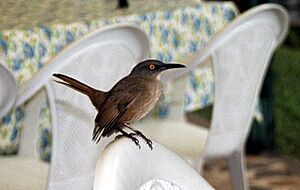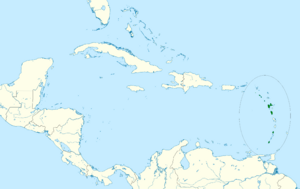Brown trembler facts for kids
Quick facts for kids Brown trembler |
|
|---|---|
 |
|
| In Dominica | |
| Conservation status | |
| Scientific classification | |
| Genus: |
Cinclocerthia
|
| Species: |
ruficauda
|
 |
|
The brown trembler (Cinclocerthia ruficauda) is a cool species of bird. It belongs to the Mimidae family, which includes mockingbirds and thrashers. You can find this bird on several islands in the Lesser Antilles of the Caribbean Sea. These islands include Saba, St. Kitts, Nevis, Montserrat, Guadeloupe, Dominica, and St. Vincent.
Contents
About the Brown Trembler's Family
Scientists are still learning about the different types of trembler birds. The International Ornithological Committee (IOC) recognizes the brown trembler and the grey trembler. They also divide the brown trembler into four main groups, called subspecies. These are C. r. ruficauda, C. r. pavida, C. r. tremula, and C. r. tenebrosa. Some experts think that the brown tremblers living north of Guadeloupe might even be a completely different species!
What Does a Brown Trembler Look Like?
The brown trembler is a medium-sized bird. It is about 20.5 to 26 centimeters (8 to 10 inches) long. Males usually weigh between 47.6 and 65.4 grams (1.7 to 2.3 ounces). Females are a bit lighter, weighing from 42.8 to 71 grams (1.5 to 2.5 ounces).
This bird has a long beak that curves slightly downwards. The female's beak is usually longer than the male's. Most of their feathers are shades of brown. Their head is a deep grayish-brown, and their back is an olive-brown. Their rump and tail feathers are a reddish-brown color.
Around their eyes, their face looks blackish. Their cheeks are a grayish-olive brown. The chin and throat are a pale grayish-buff, which turns browner on their chest and belly. Their sides are a cinnamon color. Young brown tremblers look similar but might have faint dark spots on their chest.
The different subspecies have slight variations. For example, C. r. pavida is larger than the main group. C. r. tenebrosa has darker upper feathers. C. r. tremula is also similar but much bigger.
Where Do Brown Tremblers Live?
The C. r. pavida subspecies lives in the most places. You can find it in the northern Lesser Antilles, from Saba down to Montserrat. The C. r. tremula subspecies only lives on Guadeloupe. The C. r. ruficauda subspecies is found only on Dominica. And C. r. tenebrosa lives only on St. Vincent.
Brown tremblers mostly live in humid evergreen forests. But they can also be found in younger forests that are growing back. Sometimes, they live in plantations too. They can live from sea level up to about 900 meters (3,000 feet) high.
How Do Brown Tremblers Behave?
Tremblers get their name from a special behavior. They drop their wings and hold them slightly away from their body. Then, they make very fast up-and-down and side-to-side movements. It looks like they are trembling!
What Do Brown Tremblers Eat?
Brown tremblers look for food in different places. They search on the ground, in the lower parts of trees, and in the middle sections of trees. They use their beak to toss leaves around. They also poke into plants that grow on other plants, like epiphytes. They check gaps between vines and tree trunks, and look through bunches of dead leaves. Their diet includes many different fruits, small insects and spiders, and even tiny animals.
How Do Brown Tremblers Raise Their Young?
We don't know a lot about how brown tremblers breed. It seems they usually lay eggs in March and April. Only one nest has been officially recorded. It was found in a coconut palm tree. The nest was shaped like a cup and made of small roots. It was lined with even finer roots and dead leaves.
What Do Brown Tremblers Sound Like?
The main song of the brown trembler is a series of loud, changing sounds. Some sounds are a bit harsh, while others are rich and warbling. Some can even be high and squeaky! They also have "subsongs" which they sing less often. A common call they make is a nasal, rasping sound like yeeeah. They often repeat this call many times.
Is the Brown Trembler in Danger?
The IUCN (International Union for Conservation of Nature) says the brown trembler is a species of "Least Concern." This means they are not currently in danger of disappearing. However, we don't know exactly how many brown tremblers there are. We also don't know if their numbers are going up or down. It's possible that if more forests are cut down, their population could decrease.


